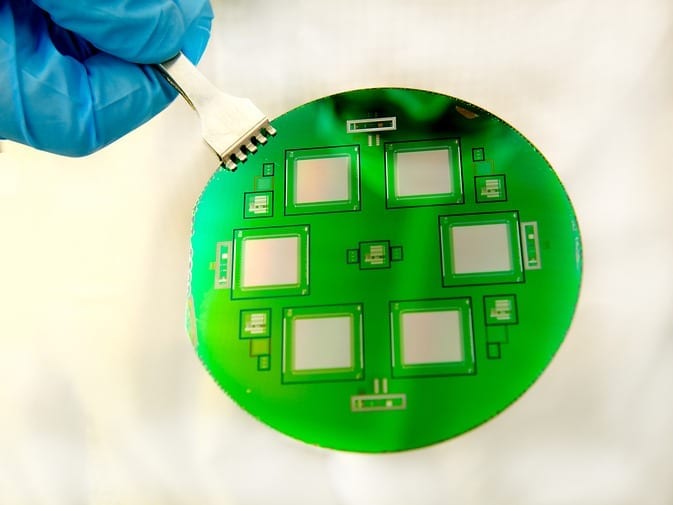
Image Credit: NASA/Bill Hrybyk
NASA technologists have hurdled a number of significant technological challenges in their quest to improve an already revolutionary observing technology originally created for the James Webb Space Telescope.
The team, led by Principal Investigator Harvey Moseley, a scientist at NASA’s Goddard Space Flight Center in Greenbelt, Maryland, has demonstrated that electrostatically actuated microshutter arrays — that is, those activated by applying an specific voltage — are as functional as the current technology’s magnetically activated arrays. This advance makes them a highly attractive capability for potential Explorer-class missions designed to perform multi-object observations.
“We have identified real applications — three scientists want to use our microshutter arrays and the commercial sector has expressed interest,” said Mary Li, a Goddard engineer who is working with Moseley and other team members to fully develop this already groundbreaking observing technology. “The electrostatic concept has been fully demonstrated and our focus now is on making these devices highly reliable.”
Progress, she said, is in large part due to the fact that the team successfully eliminated all macro-moving parts — in particular, a large magnet — and dramatically lowered the voltage needed to actuate the microshutter array. In addition, the team applied advanced electronic circuitry and manufacturing techniques to assure the microshutter arrays’ dependable operation in orbit, Li added.
The Microshutter Breakthrough
Considered among the most innovative technologies to fly on the Webb telescope, the microshutter assembly is created from micro-electro-mechanical technologies and comprises thousands of tiny shutters, each about the width of a human hair.
Assembled on four postage-size grids or arrays, the 250,000 shutters open or close individually to allow only the light from targeted objects to enter Webb’s Near Infrared Spectrograph (NIRSpec), which will help identify types of stars and gases and measure their distances and motions. Because Webb will observe faint, far-away objects, it will take as long as a week for NIRSpec to gather enough light to obtain good spectra.
NIRSpec’s microshutter array, however, enhances the instrument’s observing efficiencies. It will allow scientists to gather spectral data on 100 objects at a time, vastly increasing the observatory’s productivity. When NASA launches the Webb telescope in 2018, it will represent a first for multi-object spectroscopy.
Read more . . .
The Latest on: Microshutter technology
[google_news title=”” keyword=”Microshutter technology” num_posts=”10″ blurb_length=”0″ show_thumb=”left”]
via Google News
The Latest on: Microshutter technology
- MIT Technology Reviewon May 4, 2024 at 3:06 am
Our editors picked the 50 companies that are smartest about how they combine innovative technology with an effective business model. Some are new companies and startups, while others have ...
- 10 Best Technology Mutual Funds Of May 2024on May 2, 2024 at 4:03 am
Commissions do not affect our editors' opinions or evaluations. Over the past 10 years, the technology sector has enjoyed stratospheric performance. You can’t even match the tech funds category ...
- Technology and the Interneton April 29, 2024 at 5:00 pm
An experimental F-16 fighter jet took the U.S. Air Force secretary on a history-making flight controlled by artificial intelligence and not a human pilot.
- Technologyon April 29, 2024 at 5:00 pm
May 7, 2024 • Investigating the relationship between our technology and our bodies — and how we can fix it. May 3, 2024 • Wildlife ecologists have seen white-tailed deer expanding their ...
- How countries are using innovative technology to preserve ocean lifeon April 22, 2024 at 9:35 am
Candace Fields works with FinPrint and is using innovative technology to collect new data to see if these protected areas help reef shark populations rebound. "These MPAs might be the way to kind ...
- What's after AI? The next watershed technology could be quantum computingon April 4, 2024 at 11:00 pm
"Companies are betting billions of dollars on this field," one expert said. Artificial intelligence commands the attention of corporate giants and political leaders but a global race is underway ...
- Technologyon February 6, 2024 at 6:50 am
In a new series, we will test the limits of the latest AI technology by pitting it against human experts. Wind turbines can pose a deadly risk to migrating birds, but there are ways to ...
- Audio Production and Technology—BSon February 3, 2024 at 1:59 pm
You can’t see speakers, but you know there must be a ton of them because the sound is coming from everywhere. The system and technology behind this must be incredible. So are the audio technologists ...
- Technology Enhanced Teachingon November 21, 2023 at 7:10 pm
Academic Technology works with faculty to support their use of technology to enhance teaching and learning. Instructional Technology, Graphics, and Media Systems staff partner with faculty to design, ...
- Financial Technologyon November 1, 2023 at 6:46 am
With a comprehensive portfolio of marketplace technology, surveillance, risk management and regulatory reporting capabilities, the Financial Technology business is established to be a platform ...
via Bing News









